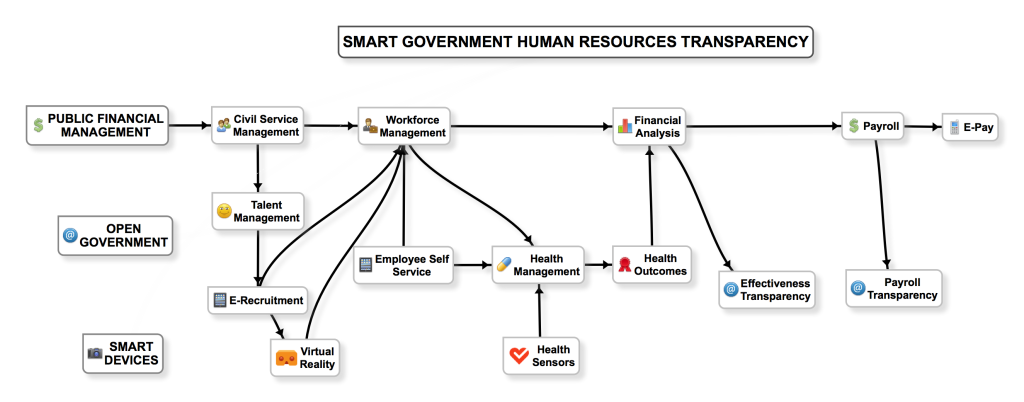Freebalance Vision Case
Public Financial Management (PFM) plays a significant role in smart government. FreeBalance is developing numerous “vision cases” to describe the intersection of PFM and “smart”. The planning and implementation of smart cities is enabled through PFM techniques and the use of open government.
Civil service management cannot become ‘smart HR’ without citizen centric technology. Governments face numerous human capital challenges on a daily basis, yet tend to address these issues without taking a look smart technologies. Civil service management systems are typically fragmented and lack agile talent management, specifically workforce planning. Identifying skill sets, job placements, time & attendance and managing productivity is often a lengthy and disorganized process. Smart Civil Service Management combined with citizen centric input helps to solve workforce and talent management challenges faced by the public sector. 
- Talent Management & Recruitment –onboarding is a costly process, but it can become less costly with smart technology. Virtual Reality and Augmented Reality will enable candidates to “try out” a job before committing to the position by shadowing their manager in the desired role.
- Workforce Management–smart technology allows communication with civil servants across various platforms. Positions, compensation, and employee information can be easily managed through web portals and using online apps. Internal communication can be further improved using smart online chat tools. VR headset and technologies like HoloLens and Holoportation will allow you to communicate with colleagues in 3D format as if they are next to you. Managing multi-cultural projects will become less expensive (example – reduction of travel & expense costs), and will enable access to your colleagues and virtual office on a single platforms
- Self Service Portals – easily accessible by employees manage their own training, payroll, positions, vacation, time & attendance. It allows civil servants to access their own data with greater flexibility, speed, and engage with their employer in real time. Enhanced analytics and back end systems generate important information about what are important features and peak usage levels
- Sensors: sensors with RFID chips help to manage health and wellness of employees. If employees are feeling ill or tired, sensors generate alerts and communicate with self-service portals or workforce management to transmit data about employees’ wellbeing. Moreover, information gathered can be also synched phone, tablet or a ‘smart’ watch on an open government platform.
- Financial Analysis: payroll costs are linked on an open GRP platform. Budgets are allocated to onboarding, talent management, payroll, while the effectiveness of health programs on productivity is measure. Salary scales are adjusted and bonuses can be provided.
- Payroll: payroll is connected to workforce management on an open government resource planning platform. Payroll can be administered using smart technology and online apps to reduce costs and improve efficiency
- Transparency: provides transparency in on-line portals about government efficiency and effectivenss and salary costs for senior government executives
Smart Governance
The integration of PFM, open government and digital devices provides the “smart” in Smart Government:
- Citizen-centric: provides human resources transparency for citizens in recruitment, effectivess and payroll
- Data-driven: leverages data from many sources
- Performance-focused: identifies productivity in Civil Service Management by monitoring progress and delivery of results and services
- Long-term: leverages collected data for smarter budget planning and workforce management
